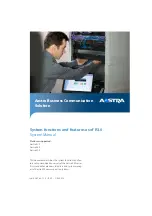
Index–2
control menu button 3–10
creating workstation configuration files A–9
current specifications B–2
D
Dedicated E1 cable
description of C–7
illustration of 2–7
pin assignments C–7
Dedicated E1 module, interface illustration
of 2–7
Default MCS to Connect setting 3–7, A–13
dialed connection for MCS workstation
description of A–3
illustration of A–5
dialog boxes
Add MCS 3–5
Change MCS Timezone/Time/Date 3–11
MCS Connection Settings 3–5, A–11
MCS Connections 3–4, A–11
MCS Date/Time 3–10
MCS Timezone/Date/Time 3–10
MCS Workstation 3–4
New Password 3–9
Open MCS Workstation Configuration
File A–9
User Identification 3–8
Workstation 3–6, A–13
directly connected MCS workstation
description of A–3
illustration of A–4
disk space requirements 1–7
display driver setting 1–7
display resolution 1–7
dissipation of power B–2
E
E1/ISDN cable
Aculab
description of C–9
illustration of 2–8
pin assignments C–10
types C–10
Promptus
description of C–12
illustration of 2–11
pin assignments C–13
E1/ISDN module
Aculab, interface illustration of 2–8
Promptus, interface illustration of 2–11
E1-to-LIU cable C–10
electrostatic discharge B–3
environmental specifications B–3
Ethernet adapter
cable 2–12
cable pin assignments C–14
connection guidelines A–4
workstation connection to a LAN 1–8
F
File menu A–15
frequency specifications B–2
G
graphics card resolution 1–7
H
hanging up 3–12
hard-disk space requirements 1–7
hardware configuration sheet, using 1–1
heat generation B–3
HSD module
interface illustration of 2–13
RS-449 cables C–21
V.35 cables C–26
X.21 cables C–29, C–30
humidity specifications B–3
I
identifying
cables C–1
connectors 1–11
switches 1–11
input current for
SmartLink 1000 B–2
SmartLink 2000 B–2
input frequency for
SmartLink 1000 B–2
SmartLink 2000 B–2





































